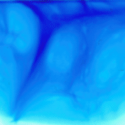Hot electrons, cold lattice
The Vulcan laser at Rutherford Appleton Laboratory is capable of producing up to a petawatt of power in a short pulse. Such an intense light source can quickly heat up the loosely bound electrons in a target to tens of thousands of degrees, while the ions in the target temporarily remain relatively “cold.” As reported in Physical Review Letters, the ability to create such an out-of-equilibrium situation is allowing researchers to explore an interesting materials regime: the effect of crystal structure on the conduction of ultrahot electrons.
Paul McKenna at the University of Strathclyde in Glasgow and colleagues used picosecond-long pulses of joule light from the Vulcan laser to produce a hot current in three carbon-based targets: single-crystal diamond, vitreous carbon, and pyrolytic carbon. The team imaged the spread of the hot current through the material indirectly by looking at the profile of proton beams produced by electron-induced fields at the rear of the target.
The electrons spread out most uniformly in diamond, while in the other forms of carbon, they tend to follow a more filamentary path. McKenna et al. explain their results using simulations, which show that although diamond is an insulator at room temperature, when its electrons are heated to extreme temperatures, diamond’s pristine structure offers little resistance compared to the disordered structure of vitreous carbon.
The findings could play a role in determining the best target materials for applications in laser-driven fusion and ion acceleration. – Jessica Thomas





